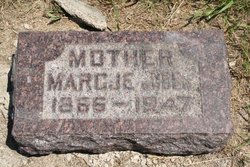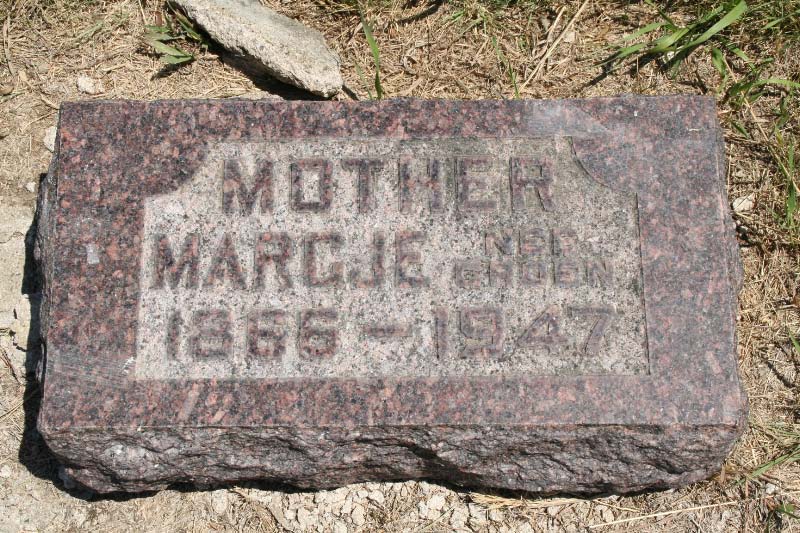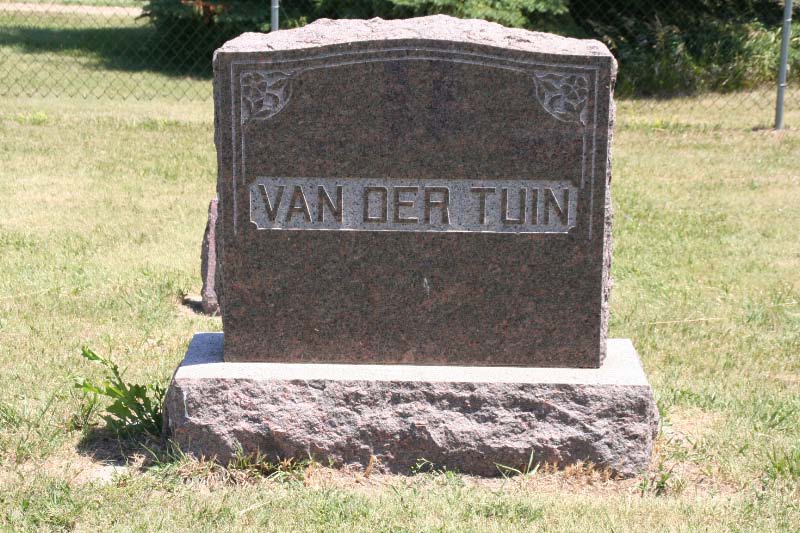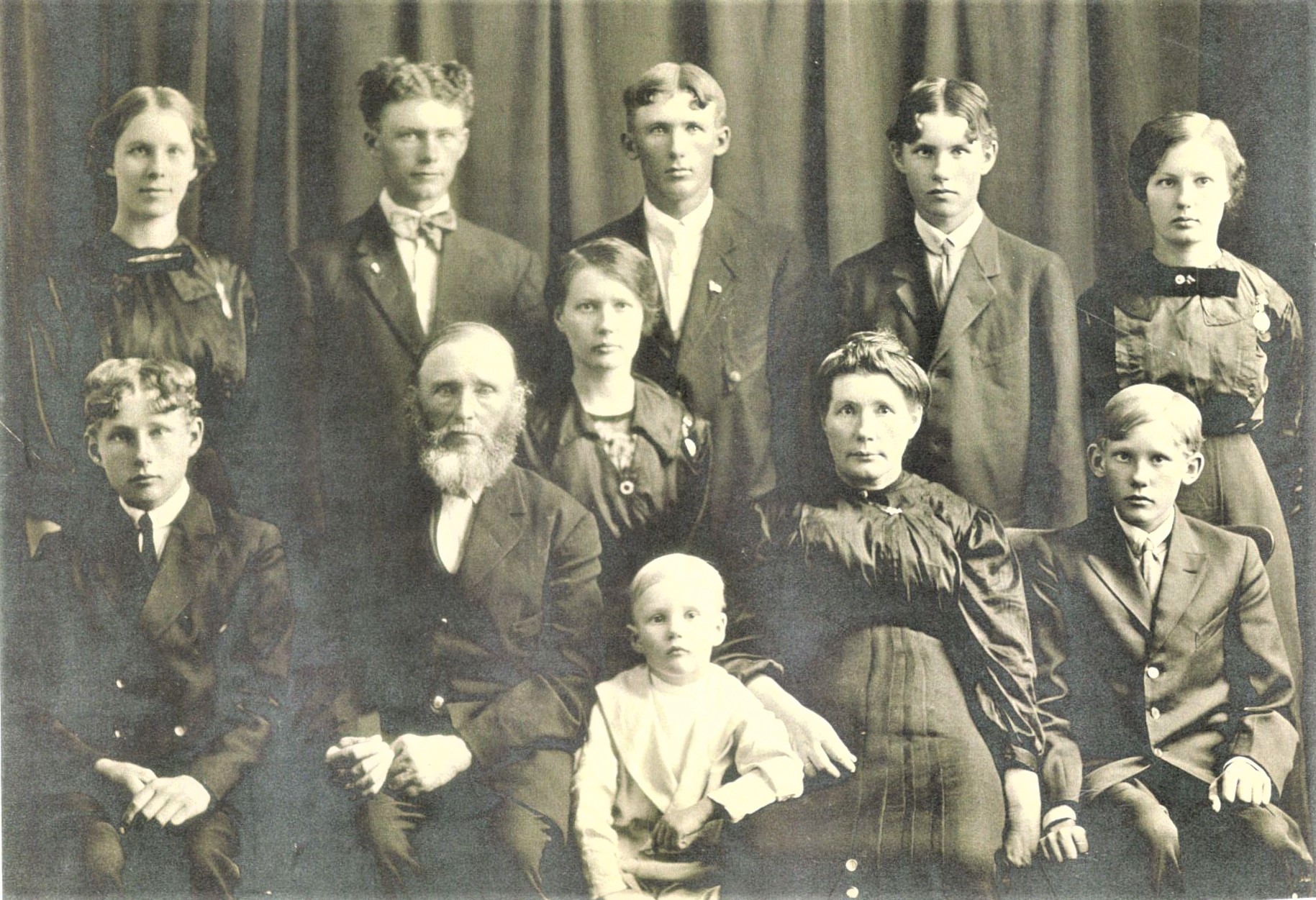In May 1887 she moved from her parental home in Oldetrijne to the nearby dairy farmers village of Oldelamer, very probably to work as a housemaid for the almost 19 years older farmhand Johannes van der Tuin, to whom she married in May 1888. From April 1889 until September 1892 three children, Jan, Johannes and Hiltje were born in Oldelamer, house number 25/2.
In the Population Register 1880-1890 Margje was noted Christian Reformed and her husband Johannes at first Dutch Reformed, but later on this was changed to Christian Reformed. It's obvious that Margje persuaded Johannes to adopt her religion.
On 24 March 24, 1893 the Van der Tuin family left their home in Oldelamer for emigrating to North America, South Dakota, Charles Mix County, Edgerton. April 7, 1893 the following family arrived on the ship Veendam of the Holland America Line (HAL) from Rotterdam at the port of New York, Ellis Island: Marrigje van der Tuin (26), her husband Johan van der Tuin, 46 years old, farmer, and their children Jan (3), Johan (2) and Hiltje (6 months) van der Tuin. Their last residence place was Wolvega, the seat of the municipality Weststellingwerf, Friesland, NL, and their destination was South Dakota. Very probably they travelled by train from Wolvega to the port of Rotterdam. They had 7 pieces of baggage with them. On the same ship and date Margje Groen's parents and their five children (siblings of Margje) emigrated from Oldetrijne (Wolvega) to South Dakota, USA. They traveled by train in a group of 32 persons, including the parents and siblings of Margje Groen, to the depot in Armour, the seat of Douglas County, located in the southeastern part of South Dakota, because the railroad didn't go any further yet. Henrick Kuipers brought them on two wooden farmer's wagons with all their belongings to the small farmer's place [Old] Platte in the neighboring, more west lying Charles Mix County, not far away east of the Missouri River, where they arrived on 11 April 1893. Much more Dutch emigrants settled in Platte, almost everyone with a farmer's background. In total the Van der Tuin and Groen families traveled 12 days by sea, five days by train and two by horse and wagon. According to grandson Everett Vander Tuin they lived for some years with the family Groen in the small agrarian township of Castalia, postoffice Nieveen, located about 7-8 mile west of present Platte. In 1900 the buildings of Edgerton, Old Platte and Castalia were moved a few miles to the place where a new railroad ended, forming the "new" Platte settlement.
In June 1894 their child Anna was born at Platte, in May 1896 Elisabeth (Lizzie) and in January 1898 Sikke (Sip) at Nieveen). Source: State Census 1905. Nieveen, named for the village Nijeveen (New Peat), located in the northeastern part of the Netherlands, can't be found anymore on the map of South Dakota, but the name Castalia Township still exists, about 8 mile west of Platte. Nieveen was lying approximately 7 mile southsouthwest of Platte.
State Census 1895: J. van der Tuin lived with his five family members in Platte Township, Charles Mix County, South Dakota. One member [Anna] was born in the USA, all the others, including Johannes, in the Netherlands.
Between January 1898 and December 1899 the family Vander Tuin moved from the Platte area about 12 miles in northeastern direction to a farm located 2,5 mile southwest of the Dutch agrarian settlement of New Holland in Clark Township, Douglas County, South Dakota, where the children Albert (December 1899), Bonne (July 1901), Jochem (July 1904, died in February 1905) and Adrian (Ed, June 1908) Vander Tuin were born.
In June 1900 Mary (34 years old, born in December 1866 in Holland, mother of 7 living children), her husband Johannes Vander Tuin (53, January 1847, Holland, farmer), their children Johannes (10, December 1890, Holland), Hilda (8, August 1892, Holland), Annie (6, June 1894, South Dakota), Lizzie (4, May 1896, South Dakota), Sippie (2, January 1898, South Dakota) and Albert (1, December 1899, South Dakota) were living at a rented farm in Clark Township, Douglas County, South Dakota.
On May 7, 1910 Mary (47, mother of 1 deceased and 9 living children), her husband Johannis Van Der Tuin (63, farmer), and their children John (19, home farmer), Hilda (17), Lizzie (13), Sip (12, home farmer), Albert (10), Bonna (8, South Dakota) and Adrian Vandertuin (1 year and 10 months old, South Dakota) were still living at a rented farm in Clark Township, Douglas, South Dakota.
On May 25, 1910 Mary (42, Holland, immigrated in 1894 [has to be: 1893], mother of 1 deceased and 9 living children), her husband John Vendertuin (63, Holland, immigrated in 1894 [has to be: 1893], farmer), their son John (21, Holland, immigrated in 1894 [has to be: 1893], farm laborer) and daughter Anna (15, South Dakota) were for a few years also living at their own farm in Tripp County, located in the southern part of South Dakota, west of the Missouri River.
In February 1920 Margret (53), her husband John Vandertuin (73, farmer), their children John (30, farm laborer), Johannes (29, Holland, farm laborer), Anna (25), Sip (22, South Dakota, farm laborer), Albert (20, South Dakota), Bonne (19, South Dakota) and Adrian (11, South Dakota) were living in Clark Township, located immediately southwest of New Holland, Douglas County, South Dakota.
Her husband Johannes van der Tuin died in January 1927 at the age of 80 years in New Holland, South Dakota.
In April 1930 M Vander Tuin (63, immigrated in 1893, widow) and her sons John (40, immigrated in 1893, carpenter), Johannes (39, painter, immigrated in 1893), Albert (30, teacher) and Adrain (21, farm laborer) were still living at their own farm in Clark Township, Douglas County, South Dakota. Right next to them her son Bonne Vander Tuin (28, South Dakota, farmer), his wife Rickie (24, South Dakota) and their son John (9 months, South Dakota) were living at a rented farm.
Margje died in June 1947 at the age of 80 years in New Holland, Douglas County, South Dakota.
The Groens and the Vander Tuins were and are still Christian Reformed (Gereformeerd).
In May 1887 she moved from her parental home in Oldetrijne to the nearby dairy farmers village of Oldelamer, very probably to work as a housemaid for the almost 19 years older farmhand Johannes van der Tuin, to whom she married in May 1888. From April 1889 until September 1892 three children, Jan, Johannes and Hiltje were born in Oldelamer, house number 25/2.
In the Population Register 1880-1890 Margje was noted Christian Reformed and her husband Johannes at first Dutch Reformed, but later on this was changed to Christian Reformed. It's obvious that Margje persuaded Johannes to adopt her religion.
On 24 March 24, 1893 the Van der Tuin family left their home in Oldelamer for emigrating to North America, South Dakota, Charles Mix County, Edgerton. April 7, 1893 the following family arrived on the ship Veendam of the Holland America Line (HAL) from Rotterdam at the port of New York, Ellis Island: Marrigje van der Tuin (26), her husband Johan van der Tuin, 46 years old, farmer, and their children Jan (3), Johan (2) and Hiltje (6 months) van der Tuin. Their last residence place was Wolvega, the seat of the municipality Weststellingwerf, Friesland, NL, and their destination was South Dakota. Very probably they travelled by train from Wolvega to the port of Rotterdam. They had 7 pieces of baggage with them. On the same ship and date Margje Groen's parents and their five children (siblings of Margje) emigrated from Oldetrijne (Wolvega) to South Dakota, USA. They traveled by train in a group of 32 persons, including the parents and siblings of Margje Groen, to the depot in Armour, the seat of Douglas County, located in the southeastern part of South Dakota, because the railroad didn't go any further yet. Henrick Kuipers brought them on two wooden farmer's wagons with all their belongings to the small farmer's place [Old] Platte in the neighboring, more west lying Charles Mix County, not far away east of the Missouri River, where they arrived on 11 April 1893. Much more Dutch emigrants settled in Platte, almost everyone with a farmer's background. In total the Van der Tuin and Groen families traveled 12 days by sea, five days by train and two by horse and wagon. According to grandson Everett Vander Tuin they lived for some years with the family Groen in the small agrarian township of Castalia, postoffice Nieveen, located about 7-8 mile west of present Platte. In 1900 the buildings of Edgerton, Old Platte and Castalia were moved a few miles to the place where a new railroad ended, forming the "new" Platte settlement.
In June 1894 their child Anna was born at Platte, in May 1896 Elisabeth (Lizzie) and in January 1898 Sikke (Sip) at Nieveen). Source: State Census 1905. Nieveen, named for the village Nijeveen (New Peat), located in the northeastern part of the Netherlands, can't be found anymore on the map of South Dakota, but the name Castalia Township still exists, about 8 mile west of Platte. Nieveen was lying approximately 7 mile southsouthwest of Platte.
State Census 1895: J. van der Tuin lived with his five family members in Platte Township, Charles Mix County, South Dakota. One member [Anna] was born in the USA, all the others, including Johannes, in the Netherlands.
Between January 1898 and December 1899 the family Vander Tuin moved from the Platte area about 12 miles in northeastern direction to a farm located 2,5 mile southwest of the Dutch agrarian settlement of New Holland in Clark Township, Douglas County, South Dakota, where the children Albert (December 1899), Bonne (July 1901), Jochem (July 1904, died in February 1905) and Adrian (Ed, June 1908) Vander Tuin were born.
In June 1900 Mary (34 years old, born in December 1866 in Holland, mother of 7 living children), her husband Johannes Vander Tuin (53, January 1847, Holland, farmer), their children Johannes (10, December 1890, Holland), Hilda (8, August 1892, Holland), Annie (6, June 1894, South Dakota), Lizzie (4, May 1896, South Dakota), Sippie (2, January 1898, South Dakota) and Albert (1, December 1899, South Dakota) were living at a rented farm in Clark Township, Douglas County, South Dakota.
On May 7, 1910 Mary (47, mother of 1 deceased and 9 living children), her husband Johannis Van Der Tuin (63, farmer), and their children John (19, home farmer), Hilda (17), Lizzie (13), Sip (12, home farmer), Albert (10), Bonna (8, South Dakota) and Adrian Vandertuin (1 year and 10 months old, South Dakota) were still living at a rented farm in Clark Township, Douglas, South Dakota.
On May 25, 1910 Mary (42, Holland, immigrated in 1894 [has to be: 1893], mother of 1 deceased and 9 living children), her husband John Vendertuin (63, Holland, immigrated in 1894 [has to be: 1893], farmer), their son John (21, Holland, immigrated in 1894 [has to be: 1893], farm laborer) and daughter Anna (15, South Dakota) were for a few years also living at their own farm in Tripp County, located in the southern part of South Dakota, west of the Missouri River.
In February 1920 Margret (53), her husband John Vandertuin (73, farmer), their children John (30, farm laborer), Johannes (29, Holland, farm laborer), Anna (25), Sip (22, South Dakota, farm laborer), Albert (20, South Dakota), Bonne (19, South Dakota) and Adrian (11, South Dakota) were living in Clark Township, located immediately southwest of New Holland, Douglas County, South Dakota.
Her husband Johannes van der Tuin died in January 1927 at the age of 80 years in New Holland, South Dakota.
In April 1930 M Vander Tuin (63, immigrated in 1893, widow) and her sons John (40, immigrated in 1893, carpenter), Johannes (39, painter, immigrated in 1893), Albert (30, teacher) and Adrain (21, farm laborer) were still living at their own farm in Clark Township, Douglas County, South Dakota. Right next to them her son Bonne Vander Tuin (28, South Dakota, farmer), his wife Rickie (24, South Dakota) and their son John (9 months, South Dakota) were living at a rented farm.
Margje died in June 1947 at the age of 80 years in New Holland, Douglas County, South Dakota.
The Groens and the Vander Tuins were and are still Christian Reformed (Gereformeerd).
Family Members
-
![]()
John Vander Tuin
1889–1967
-
![]()
Johannes "Hannes" Vander Tuin
1890–1965
-
![]()
Hiltje "Hilda" Vander Tuin Krediet
1892–1978
-
![]()
Anna Vander Tuin Likkel
1894–1985
-
![]()
Elisabeth "Lizzie" Vander Tuin Veurink
1896–1976
-
![]()
Sip Vander Tuin
1898–1973
-
![]()
Albert Vander Tuin
1899–1994
-
![]()
Bonne Vander Tuin
1901–1978
-
Jochem Vander Tuin
1904–1905
-
![]()
Adrian "Ed" Vander Tuin
1908–1994
Sponsored by Ancestry
Advertisement
See more van der Tuin or Groen memorials in:
- New Holland Cemetery van der Tuin or Groen
- Douglas County van der Tuin or Groen
- South Dakota van der Tuin or Groen
- USA van der Tuin or Groen
- Find a Grave van der Tuin or Groen
Advertisement






















